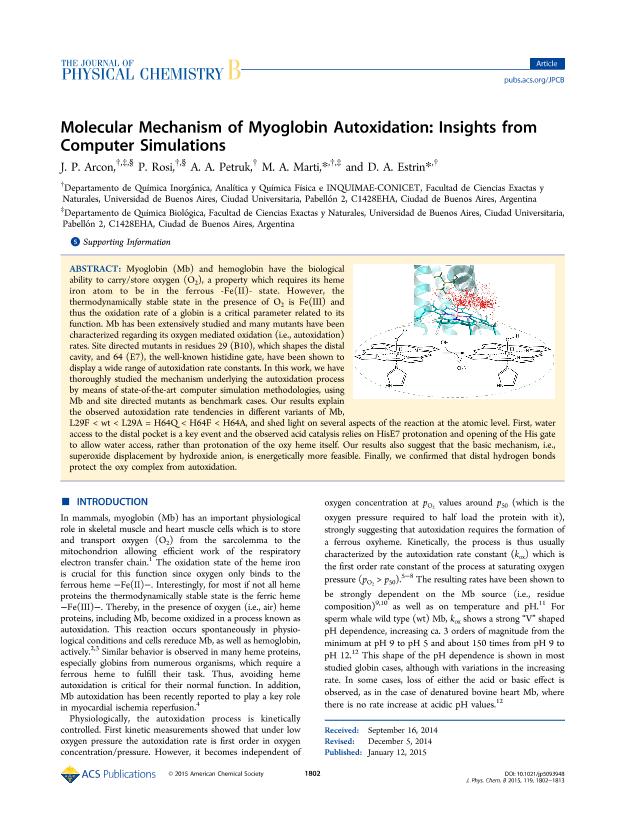Artículo
Molecular mechanism of myoglobin autoxidation: Insights from computer simulations
Arcon, Juan Pablo ; Rosi, Pablo Eduardo
; Rosi, Pablo Eduardo ; Petruk, Ariel Alcides
; Petruk, Ariel Alcides ; Marti, Marcelo Adrian
; Marti, Marcelo Adrian ; Estrin, Dario Ariel
; Estrin, Dario Ariel
 ; Rosi, Pablo Eduardo
; Rosi, Pablo Eduardo ; Petruk, Ariel Alcides
; Petruk, Ariel Alcides ; Marti, Marcelo Adrian
; Marti, Marcelo Adrian ; Estrin, Dario Ariel
; Estrin, Dario Ariel
Fecha de publicación:
01/2015
Editorial:
American Chemical Society
Revista:
Journal of Physical Chemistry A
ISSN:
1520-6106
e-ISSN:
1089-5639
Idioma:
Inglés
Tipo de recurso:
Artículo publicado
Clasificación temática:
Resumen
Myoglobin (Mb) and hemoglobin have the biological ability to carry/store oxygen (O2), a property which requires its heme iron atom to be in the ferrous -Fe(II)- state. However, the thermodynamically stable state in the presence of O2 is Fe(III) and thus the oxidation rate of a globin is a critical parameter related to its function. Mb has been extensively studied and many mutants have been characterized regarding its oxygen mediated oxidation (i.e., autoxidation) rates. Site directed mutants in residues 29 (B10), which shapes the distal cavity, and 64 (E7), the well-known histidine gate, have been shown to display a wide range of autoxidation rate constants. In this work, we have thoroughly studied the mechanism underlying the autoxidation process by means of state-of-the-art computer simulation methodologies, using Mb and site directed mutants as benchmark cases. Our results explain the observed autoxidation rate tendencies in different variants of Mb, L29F < wt < L29A = H64Q < H64F < H64A, and shed light on several aspects of the reaction at the atomic level. First, water access to the distal pocket is a key event and the observed acid catalysis relies on HisE7 protonation and opening of the His gate to allow water access, rather than protonation of the oxy heme itself. Our results also suggest that the basic mechanism, i.e., superoxide displacement by hydroxide anion, is energetically more feasible. Finally, we confirmed that distal hydrogen bonds protect the oxy complex from autoxidation.
Palabras clave:
Myoglobin
,
Autoxidation
,
QM/MM
,
Molecular Dynamics
Archivos asociados
Licencia
Identificadores
Colecciones
Articulos(INQUIMAE)
Articulos de INST.D/QUIM FIS D/L MATERIALES MEDIOAMB Y ENERGIA
Articulos de INST.D/QUIM FIS D/L MATERIALES MEDIOAMB Y ENERGIA
Articulos(IQUIBICEN)
Articulos de INSTITUTO DE QUIMICA BIOLOGICA DE LA FACULTAD DE CS. EXACTAS Y NATURALES
Articulos de INSTITUTO DE QUIMICA BIOLOGICA DE LA FACULTAD DE CS. EXACTAS Y NATURALES
Citación
Arcon, Juan Pablo; Rosi, Pablo Eduardo; Petruk, Ariel Alcides; Marti, Marcelo Adrian; Estrin, Dario Ariel; Molecular mechanism of myoglobin autoxidation: Insights from computer simulations; American Chemical Society; Journal of Physical Chemistry A; 119; 5; 1-2015; 1802-1813
Compartir
Altmétricas



